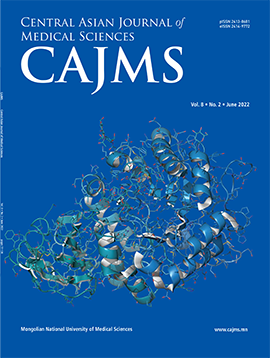Association of Carotid Intima-Media Thickness and Plague with Lipid Profiles in a High-Stroke Risk Population
DOI:
https://doi.org/10.24079/cajms.2022.12.002Keywords:
carotid artery plaque, lipids, low-density lipoprotein cholesterol, stroke, atherosclerosisAbstract
Objective: This study aimed to determine the relationship between lipid profiles, carotid intima-media thickness and plaques in a Mongolian high-stroke-risk population. Methods: A hospital-based cross-sectional study was conducted with Mongolian adults who underwent interviews, physical examinations, and laboratory testing from May through November 2022 at the Mongolia-Japan and Enerel hospitals. The subjects with a high risk of stroke were selected according to Framingham Stroke Risk Score (FSRS). Carotid ultrasonography was then performed on the high-stroke-risk participants. Results: Overall, 78 subjects with a high risk of stroke out of 280 participants were ultimately included in the analysis. Carotid plaques were identified in 43 (55.1 %) and thickened cIMT in 68 (87.2 %). Multivariate regression analysis demonstrated that non-HDL-C (B = 0.434, p < 0.05) was an independent determinant of cIMT, whereas non-HDL-C/HDL-C (OR 8.335, 95 % CI, 2.984 - 23.287, p = 0.009) and LDL-C (OR 9.085, 95 % CI, 1.490 - 55.409, p = 0.017) had the strongest association with carotid plague. Conclusions: These findings indicate that non-HDL-C was an independent risk factor for cIMT. Among the lipid profiles, non-HDL-C/HDL-C ratio and LDL-C level have the strongest association with carotid plaques in the Mongolian high-stroke-risk population.
Downloads
261
Downloads
Published
How to Cite
Issue
Section
License
Copyright (c) 2022 Mongolian National University of Medical Sciences

This work is licensed under a Creative Commons Attribution-NonCommercial 4.0 International License.




